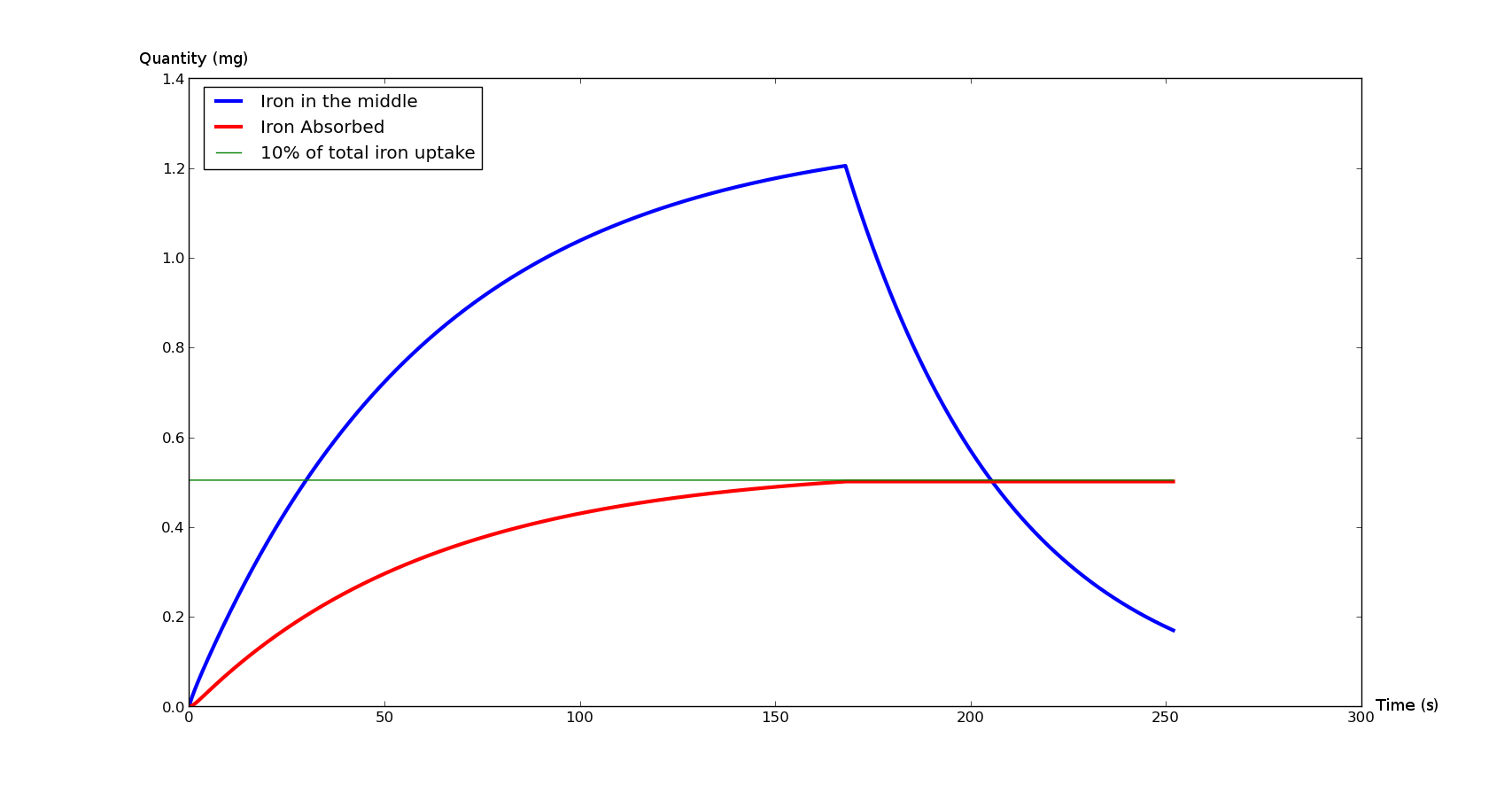Team:Evry/Modeltr1
From 2013.igem.org
Disease model
Introduction
In the very beginning of the project, we focused on the duodenum and the iron absorbed by it. In order to determine if a flush treatment strategy was viable, we first had to model the behaviour of the duodenum regarding iron absorption.
Observations
60% of iron absorption takes place in the duodenum, the last 40% in the jejunum. The duodenum is located in the upper intestines, right after the stomach, and is usually 300mm long.
A healthy person absorbs about 10% (2mg a day) of the daily iron uptake, while a hemochromatosis person's absorption varies between 50% and 100% of the daily iron uptake[1].
As seen in the Figure 1, iron absorption is normally regulated by the liver through hepcidin production. This means that after a certain delay, the iron absorption eventually reaches a stationary phase.
Goals
Our goal in this part of the model is to create a generic duodenal iron absorption model so that:
- We can have a realistic base for the Final flush treatment model
- The model can can be reused in the future
Assumptions
- Our bacteria don't settle in the duodenum
- No regulation in the patient's iron absorption
- Constant iron flow
- Homogeneous fluid
- The bacterial quantity is constant
- The bacterial natural absorption is insignificant compared to the chelation
- The patient ingests 20mg of iron per day (Guideline Daily Amounts)
Materials and methods
This model simulates the digestion process of one meal from the duodenum's point of view.
The duodenum is considered as a cylinder in which a homogeneous fluid flows. So, this model is divided into three steps: the filling of duodenum, the steady state flowing step and the emptying.
This model has two variables : the iron disolved in the middle (S) and the absorbed iron (A).
We considered the chyme arrives in the duodenum at a constant rate. S has a linear component Sp which represents the pulses. The also are an emptying component and an absorption component.
We assumed a linear absorption and a negative feedback regulation for A.
Finally:

| Name | Unit | Description | Reference |
| Sp | mol.s-1 | Iron pulse | [1][2] |
| v | m.s-1 | Chyme's flow average speed | [2] |
| L | m | Duodenum length | [3] |
| α | s-1 | Duodenum absorption rate | tuned |
| σ | s-1 | Regulation coefficient | tuned |
Parameters tuning :
As the iron absorption process greatly differs from an individual to an other, α and σ cannot be related with anything in the litterature. We thus had to tune those parameters.
First of all, we know that a hemochromatosic patient absorbs at least 50% of the iron he ingests. Thus, we tuned α to fit this information while assessing σ = 0 (Hemochromatosis : no regulation in iron absorbtion).
Then, since we know that a healthy person absorbs 10% of the ingested iron, we were able to tune σ.
Results
These curves represent the total absorbed iron (in red) and the instant iron quantity in the middle (blue).
The green line is a landmark: it represents the iron absorption of a healthy person during an average meal.
The Figure 3 was generated with the same equations as the Figure 2, but where σ = 0, which means that there is no regulation of iron absorption.
Conclusion
This model provides rational results regarding the iron absorption phenomenon. Therefore, we will be able use it as a base for the next simulations.
The next step is to include our bacterial flow in this model, which will result in the Final flush treatment model.
Models and scripts
This model was made using the Python language. You can download the python script here.
 "
"
















